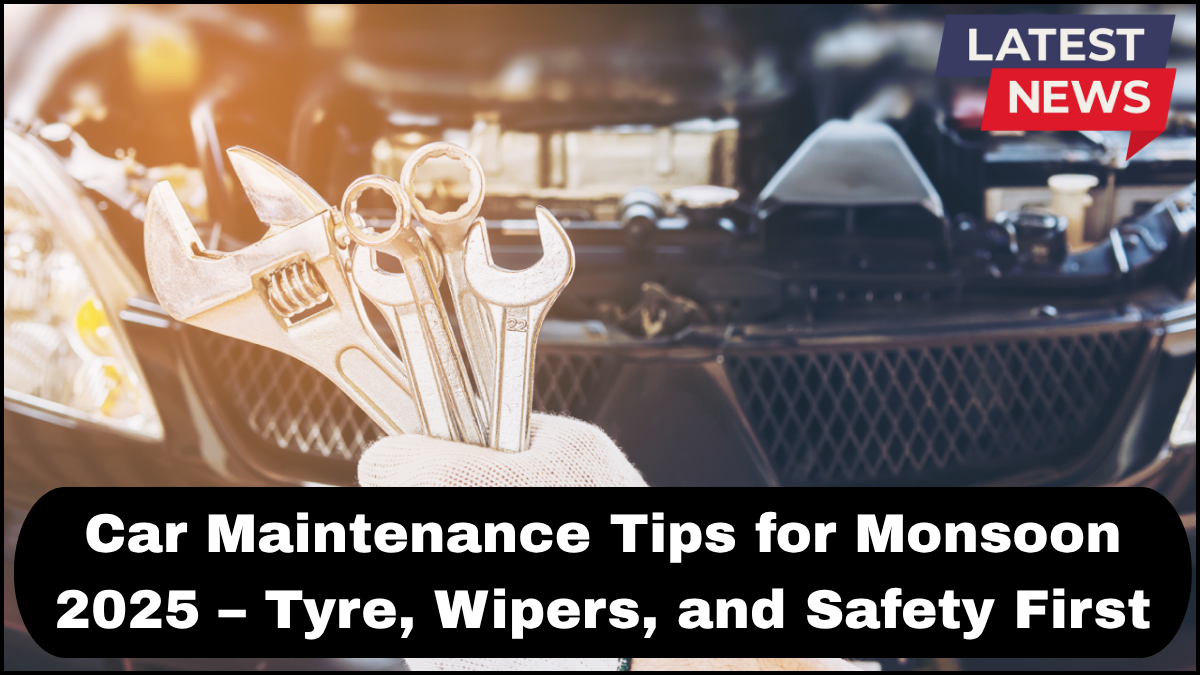The monsoon season brings relief from the heat, but it also introduces serious challenges for vehicle owners. Slippery roads, poor visibility, and increased mechanical strain make this the most demanding time of the year for your car. Staying proactive with the right monsoon car maintenance tips can help you avoid breakdowns, accidents, and costly repairs. In this guide, we’ll focus on three core areas—tyres, wipers, and overall safety—to ensure your car is monsoon-ready in 2025.

Inspect and Maintain Your Tyres
One of the most critical monsoon car maintenance tips is giving your tyres a thorough check before the rains hit.
-
Check Tread Depth: The tread is your tyre’s grip on wet roads. A minimum tread depth of 2-3mm is crucial for dispersing water and preventing hydroplaning. Anything less significantly increases the risk of skidding.
-
Look for Uneven Wear: If one side of your tyre is wearing faster than the other, it could be due to poor wheel alignment or suspension issues. Address these before the rains worsen handling.
-
Proper Inflation: Under-inflated tyres can cause sluggish steering and increased braking distances. Over-inflated ones reduce the contact area, making you more prone to skidding. Stick to the manufacturer’s recommended pressure levels.
-
Replace Damaged Tyres Promptly: Small cuts or bulges in the sidewall may seem minor, but they can become dangerous under wet conditions. Replace questionable tyres without delay.
Pro Tip: Invest in all-weather or rain-specific tyres if you live in a region prone to heavy rainfall. These offer better grip and water dispersion.
Don’t Ignore Your Wipers – Visibility Is Non-Negotiable
Wipers often get overlooked, but they’re your first line of defense against poor visibility during a downpour. A proper tyre and wiper check should be standard practice every monsoon.
-
Examine Wiper Blades for Wear and Tear: If your wipers leave streaks, make squeaky noises, or skip spots, it’s time to replace them. Rubber degrades over time, especially in hot and humid conditions.
-
Test Washer Fluid and Spray Nozzles: Make sure the washer reservoir is full with appropriate fluid—not just water. Use washer fluid that can break down dirt and grime effectively.
-
Wiper Motor Check: Slow-moving or unresponsive wipers might indicate a failing motor. Get this inspected early to avoid getting caught mid-storm with no visibility.
Maintenance Hack: Lift your wiper blades away from the windshield when parked to prevent rubber sticking or tearing, especially if the car is under direct sun before the rain starts.
Prioritize Electrical and Brake System Checks
Rain and electronics don’t mix well. Moisture can lead to short circuits or system failures, making a pre-monsoon electrical inspection essential.
-
Battery Terminals: Ensure connections are tight and corrosion-free. A weak battery may fail when exposed to moisture.
-
Brake Efficiency: Water can affect brake performance. Get your brake pads, rotors, and fluid levels inspected. Wet brakes can result in delayed stopping times—a risk not worth taking.
-
Lights and Indicators: Confirm that headlights, brake lights, fog lamps, and turn indicators are functioning properly. They are critical for your visibility and for alerting others on the road.
Interior Protection and Antifungal Measures
Monsoons can turn your car’s interior into a damp, musty space if not managed well.
-
Use Rubber Floor Mats: They trap water and prevent moisture from seeping into the carpet, reducing the chance of mold.
-
Silica Gel Packs or Moisture Absorbers: Keep these inside the cabin to avoid foggy windows and moldy smells.
-
AC System Maintenance: Ensure the air conditioning and defogging systems are working optimally. They help keep the cabin dry and windows clear.
Safety Add-ons for the Monsoon Season
It’s not just about maintaining what you already have—enhancing your car’s monsoon readiness is a smart move.
-
Emergency Kit: Include a flashlight, extra fuses, jumper cables, basic tools, and a first-aid kit. Add a raincoat and umbrella too.
-
Underbody Coating: This protects your car from rust caused by constant exposure to water and mud.
-
Windshield Treatment: Apply a rain-repellent coating to improve visibility by letting water bead and roll off more easily.
Final Thoughts
The monsoon season is as challenging as it is beautiful, and your car needs to be prepared to handle both. From essential tyre and wiper checks to deeper inspections of your vehicle’s electrical, braking, and interior systems, following these monsoon car maintenance tips will ensure that you drive safely and confidently, rain or shine.
Frequently Asked Questions (FAQs)
Q1: How often should I check my tyre pressure during the monsoon?
A: Once a week is ideal. Temperature and humidity changes can affect pressure, especially after heavy rainfall.
Q2: Can I drive with slightly worn-out wiper blades during light rain?
A: It’s not recommended. Even light rain can drastically reduce visibility, and compromised wipers will only make it worse.
Q3: Should I wash my car more often during the rainy season?
A: Yes, frequent washing removes mud, debris, and contaminants that can damage the paint and underbody.
Q4: Is it okay to use tap water in the windshield washer reservoir?
A: Avoid it. Use proper washer fluid to prevent clogging and ensure effective cleaning.
Q5: What’s the best way to keep car interiors dry during the monsoon?
A: Use moisture absorbers, air out your car regularly, and stick to rubber mats. Avoid fabric accessories during this season.
click here to learn more
